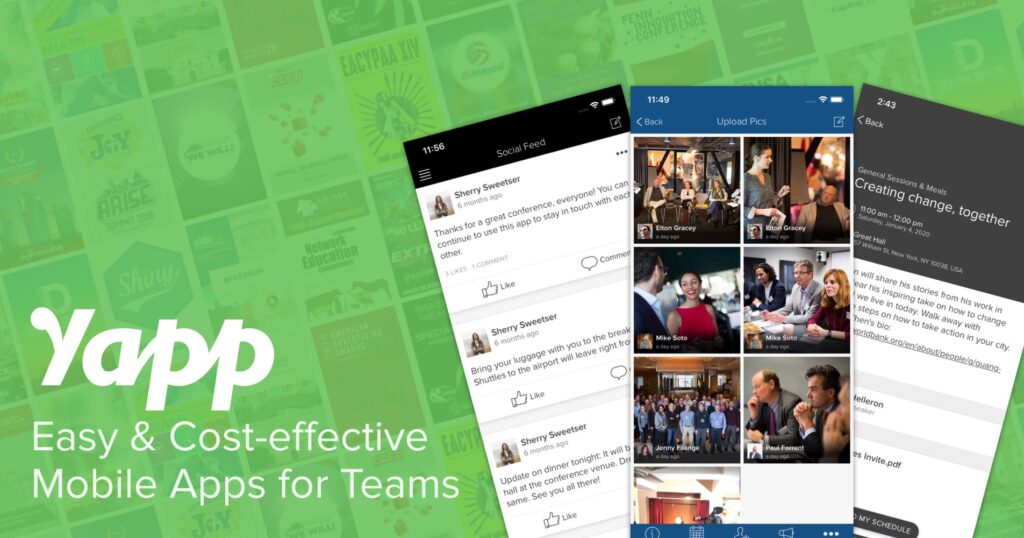How to Produce Successful In-Person Events Post COVID
As the world reopens post COVID-19 restrictions, event planners and attendees alike are excited to return to in-person events. As per The Drum, 80% of virtual event attendees are looking forward to their next in-person event.
While the basics of event management remain the same, there are some new considerations to consider when planning an in-person event today. We’ll explore those in today’s blog.
Ready to jump ahead and give your events an immediate competitive boost while saving as much as 100% on event printing costs? Try Yapp free for 14-days, and with our quick-start guide, create your next event app in as little as 15-minutes!
Stay Up-to-Date with COVID Guidelines
COVID-19 health and safety protocols from health officials are constantly evolving, so it’s important for event organizers to keep a track of any changes. Be sure to share the latest CDC guidelines with your event staff, vendors, and other key stakeholders so that everyone is on the same page.
As a part of the event planning process, determine how you will implement these guidelines at your event. For example, local restrictions may require face masks, a negative COVID test for admission, taking temperatures at the door, and distribution of hand sanitizer stations throughout the event space.
Communicate Your Safety Plan to Attendees
Attending in-person events is still a mixed bag for many people. Some are ready to jump back into the fray, while others are still feeling hesitant about being in large groups.
Keep an Open Line of Communication
Naturally, attendees will have health and safety concerns at your event. It’s your job to alleviate these concerns. The best thing you can do is communicate your safety plan to them in advance so they know what to expect. You can do this through your event website, social media channels, email marketing, and mobile event app notifications.
Know What Your Attendees Expect
You can also consider sending out a survey to your attendees before the event so that you can get feedback on specific concerns and address them accordingly.
Include an FAQ section on your event page that covers all the safety measures you’ll be taking and include a feedback section. In your email marketing, you can link to this FAQ section so that attendees have easy access to all the information they need.
By providing this information to your event audience in advance, you’ll help to put their minds at ease and make them more likely to attend your event.
Choose the Right Venue
When considering a venue, be sure to ask about their cleaning and safety protocols. Some venues may have implemented new policies, such as contactless check-in or reduced capacity.
In addition, consider the layout of the venue when determining if it’s a good fit for your event. For example, will there be enough space for attendees to social distance? Is the venue well-ventilated?
These are important factors to consider when choosing a venue and developing your in person event plans.
Have a Back-Up Plan
Even if you’ve decided to hold an in-person event, it’s still a good idea to have a backup plan in case things change. That’s why you should consider a contingency plan such as an alternate virtual or hybrid event if, for example, you reach venue capacity maximums.
There are many benefits to holding a virtual hybrid event. For one, it allows you to reach a larger audience since virtual attendees can attend from anywhere in the world. Additionally, it gives you the flexibility to make last-minute changes if necessary.
Use Technology to Your Advantage
While many people think of technology as a way to connect people virtually, it can also help you to improve your in-person events.
By leveraging the latest technology, you’ll be able to put on a successful event that attendees will remember for years to come.
Here are a few ideas to get you started:
- Use contactless check-in and ticketing: This will help to minimize contact between on-site attendees and staff.
- Use attendee apps to deliver digital experiences: An event mobile app can help attendees get the most out of your event, with easy access to a venue map, breakout session schedules, sponsor information, and networking opportunities right on their own mobile devices.
- Use beacons: Beacons help direct attendees to the correct location or provide them with information about the event.
- Use RFID wristbands: RFID wristbands can be used for a variety of purposes, such as contactless payments or storing information about the event.
Take Advantage of Curated Networking
Curated networking means that you hand-pick who attends your event. This allows you to create a more intimate event where attendees can make connections with people they are actually interested in meeting.
When done correctly, curated networking can be a powerful tool for creating long-lasting relationships. It can also help to ensure that your event is more relevant and useful for attendees.
If you’re interested in using curated networking for your event, there are a few things to keep in mind.
- Decide on criteria: You’ll need to create good criteria for who you want to invite. This will help ensure that only the most relevant and high-quality attendees are at your event.
- Create a good application process: The application process is important for two reasons. First, it will help you screen attendees and second, it will give you insight into what they’re looking to get out of the event.
- Make sure you have enough staff: Curated networking events are more intimate, which means you may need more staff to optimize the attendee experience and event content.
- Plan for no-shows: Even if you have great criteria and application process, there’s always a chance that some people will not show up. Be sure to plan for this by having a waitlist or inviting more people than you need.
Set Up A Marketing Campaign
The bottom line of being successful in the events industry stays the same regardless of a pandemic–in order to generate interest in your event, you must market it well.
Now more than ever, it is key to have a solid marketing strategy in place. You’ll need to think about things like who your target audience is and what social media platforms they use. You’ll also need to create compelling content that will pique their interest.
Once you have a solid marketing strategy in place, you can promote your event. This can be done through social media, email marketing, or even traditional methods like print ads. Here’s our in-depth guide for event promotion.
Delegate, Delegate, Delegate
Successful event professionals often say that the key to their success is delegation. This is especially true when it comes to putting on a large event.
There are a lot of moving parts when organizing an event, which can be overwhelming for one person. By delegating tasks to specific team members, you’ll be able to get things done more efficiently and with less stress.
For delegation, there are a few things to keep in mind.
- Know what can be delegated: Not everything can be delegated. You’ll need to decide what tasks can be handled by your event team and what tasks you need to do yourself. For instance, you may delegate tasks like setting up the venue or sending out invitations, but you’ll likely want to select the speakers or create the event program yourself.
- Choose the right people: Assign tasks to people who are capable of completing them and who are interested in the task. It’s a good idea to do a trial run with someone before delegating a new task to them to make sure they’re a good fit.
- Be clear about expectations: When you delegate a task, be sure to give clear instructions about what needs to be done and by when. This will help to ensure that the task is completed correctly and on time.
- Monitor progress: Even after you delegate a task, it’s important to keep an eye on progress. This will help you ensure the task is being done correctly and on schedule.
Be Flexible and Ready for Last-Minute Changes
While last-minute changes have always been a reality in the events industry, they’re even more likely to happen now. Things can change quickly and unexpectedly.
It’s crucial to be flexible and ready for last-minute changes. This means having a backup plan in place for things like venue changes or speaker cancellations. It also means being willing to make changes to your event if necessary.
For instance, you may need to change your event format from an in-person event to an online event. Or you may need to modify the agenda or speaker lineup.
The most important thing to remember is to communicate with your attendees: Keep your attendees informed of any changes or updates to your event through your event app. This will help them understand why changes are being made and what to expect.
Streamline Event Planning with Yapp
Planning a live event post-COVID-19 may seem daunting. If you feel overwhelmed, we are here to help!
With Yapp, you can create a custom event app for your event without any coding or software development experience required.
A mobile event app can enable ticketing, contactless check-in, contact tracing, ongoing notifications, and various audience engagement tools. We have a team of event industry experts who can help you with everything from marketing to on-site support.
Ready to see how we can help plan your next event? Start your free trial now!







